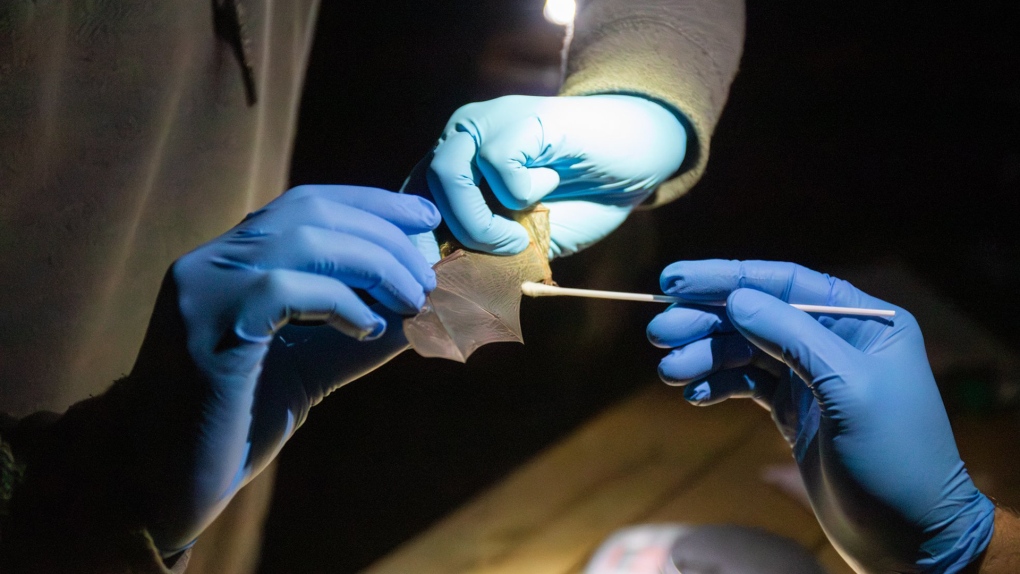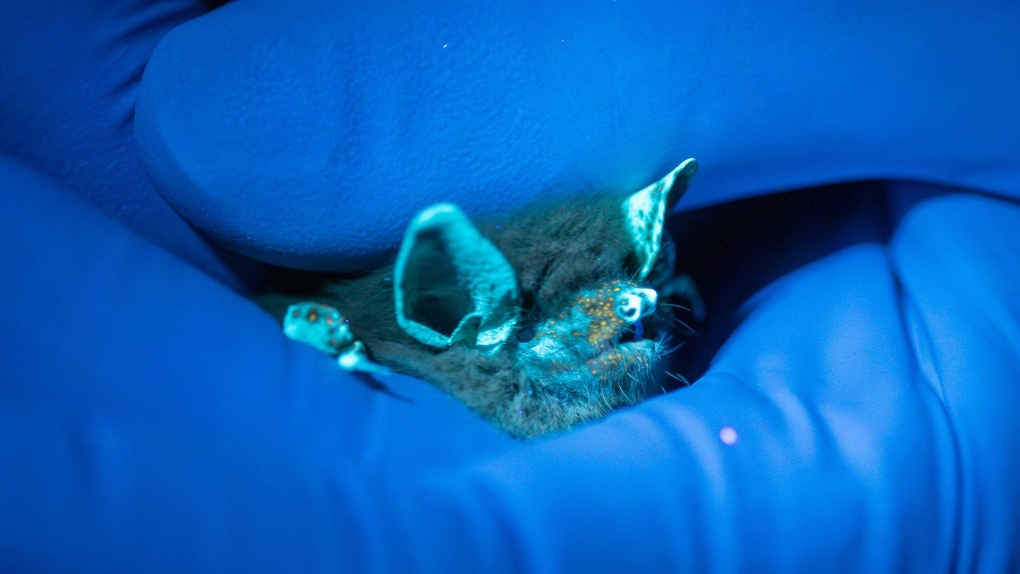Deadly bat illness found in Alberta
 Officials say they've found evidence of white-nose syndrome, an illness that's already killed millions of bats across North America. (Supplied/Alberta Bats)
Officials say they've found evidence of white-nose syndrome, an illness that's already killed millions of bats across North America. (Supplied/Alberta Bats)
White-nose syndrome has been found in bats in the largest known hibernation area in the province.
The Alberta Community Bat Program, an organization that works to protect bat populations and raise awareness about them in general, says the disease was confirmed in three little brown bats, in two separate locations, along the Red Deer River badlands.
But it's believed the disease is affecting a much larger number.
"Little brown bats are the most common bat in Alberta. If we lost them it would be a tremendous loss," said Cory Olsen, the Alberta bat program coordinator for Wildlife Conservation Society Canada.
- Sign up for breaking news alerts from CTV News, right at your fingertips
- The information you need to know, sent directly to you: Download the CTV News App
White-nose syndrome is one of the worst wildlife diseases ever recorded. It's already killed millions of bats across North America.
The disease is caused by a fungus found in caves where bats hibernate.
Olsen says the fungus was first discovered in the badlands near Dinosaur Provincial Park in 2022, but this spring is the first time bats have tested positive for the disease.
A collaboration between Wildlife Conservation Society Canada and Alberta Environment captured bats as they emerged from hibernation in early May. Tissue samples, scarring and fungus on the bat's wing confirmed white-nose syndrome.
Officials say monitoring is now underway to determine if white-nose syndrome is resulting in a decline in the brown bat population.
 (Supplied/Alberta Bats)
(Supplied/Alberta Bats)
Bats are the top predator of insects that fly at night and are important for the ecosystem and biodiversity, Alberta Bats says.
"Nobody has calculated the value of bats in Canada, but in the U.S., their value to agriculture is $23 billion a year," Olsen said.
With fewer bats, U.S. farmers are paying billions more in pest control. As the fungus spreads, there's concern Prairie farmers will face the same problems.
There is currently no cure for white-nose syndrome, but according to the province there is evidence some bat species in eastern North America are developing a resistance to the disease.
There are a number of projects underway to better understand the fungus.
"A probiotic cocktail containing beneficial microbes to inoculate bats is currently being tested in Washington," said Olsen. "As part of the work in Alberta we collected samples of the microbe that occurs on the bat wings…and we're providing samples to McMaster University where they are also working on a probiotic cocktail."
 (Supplied/Alberta Bats)
(Supplied/Alberta Bats)
On its website, Alberta Environment says the fungus can't be prevented or eradicated, but bat populations can be helped by protecting their key habitats.
"Maintaining places for bats to roost, hibernate and forage will help populations recover after initial declines."
CTVNews.ca Top Stories

Walking pneumonia is surging in Canada. Is it peaking now?
CTVNews.ca spoke with various medical experts to find out the latest situation with the typically mild walking pneumonia in their area and whether parents should be worried.
Minister calls GST holiday, $250 cheques for 18 million Canadians 'a targeted approach'
Women and Gender Equality and Youth Minister Marci Ien is calling the federal government's proposed GST holiday and $250 rebate cheques a 'targeted approach' to address affordability concerns.
'Her shoe got sucked into the escalator': Toronto family warns of potential risk of wearing Crocs
A Toronto family is speaking out after their 10-year-old daughter's Crocs got stuck in an escalator, ripping the entire toe area of the clog off.
Prime Minister Trudeau attends Taylor Swift's Eras Tour in Toronto with family
Prime Minister Justin Trudeau is a Swiftie. His office confirmed to CTV News Toronto that he and members of his family are attending the penultimate show of Taylor Swift's 'The Eras Tour' in Toronto on Friday evening.
NEW Thinking about taking an 'adult gap year'? Here's what experts say you should know
Canadian employees are developing an appetite for an 'adult gap year': a meaningful break later in life to refocus, refresh and indulge in something outside their daily routine, according to experts.
Canada's tax relief plan: Who gets a cheque?
The Canadian government has unveiled its plans for a sweeping GST/HST pause on select items during the holiday period. The day after the announcement, questions remain on how the whole thing will work.
Trump raced to pick many Cabinet posts. He took more time to settle on a treasury secretary
U.S. president-elect Donald Trump launched a blitz of picks for his Cabinet, but he took his time before settling on billionaire investor Scott Bessent as his treasury secretary nominee.
Doctor at the heart of Turkiye's newborn baby deaths case says he was a 'trusted' physician
The Turkish doctor at the center of an alleged fraud scheme that led to the deaths of 10 babies told an Istanbul court Saturday that he was a 'trusted' physician.
'Immoral depravity': Two men convicted in case of frozen migrant family in Manitoba
A jury has found two men guilty on human smuggling charges in a case where a family from India froze to death in Manitoba while trying to walk across the Canada-U.S. border.


































